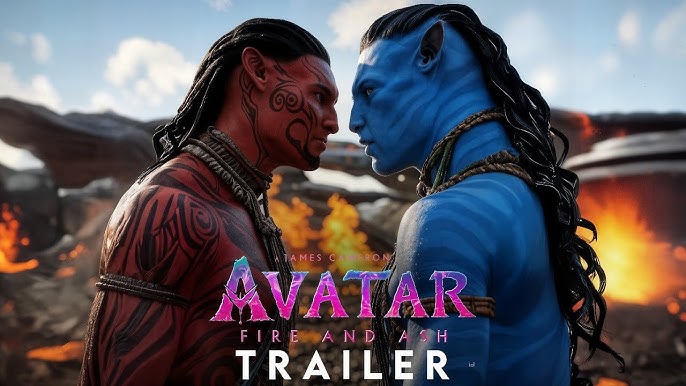Avatar 3 (2025)

Avatar 3 (2025) – The Ocean’s Call
Starring: Sam Worthington | Zoe Saldana
Avatar 3: The Ocean’s Call marks the next breathtaking chapter in James Cameron’s epic saga, returning audiences to the lush, immersive world of Pandora. After the events of the first two films, the Sully family—Jake, Neytiri, and their children—are faced with challenges unlike anything they have encountered before. This installment plunges viewers into the unexplored depths of Pandora’s vast oceans, revealing hidden realms, mysterious species, and ancient underwater civilizations that have remained hidden from the surface world for generations. With a story that blends adventure, family dynamics, and ecological themes, Avatar 3 promises to be an unforgettable cinematic journey.
The film begins by expanding the scope of Pandora beyond its familiar forests and floating mountains. Jake Sully, now a leader among the Na’vi and fully integrated into the Omaticaya tribe, must balance his responsibilities as both protector and father. Neytiri remains a formidable warrior and compassionate guide, committed to safeguarding their home while nurturing the next generation of Na’vi. The Sully children are no longer mere observers; each of them plays a unique and active role in navigating Pandora’s ever-evolving challenges. This familial focus introduces new emotional stakes, highlighting themes of responsibility, courage, and unity as the family confronts the unknown.
The central narrative revolves around the discovery of Pandora’s underwater territories. These uncharted domains contain not only breathtaking beauty—bioluminescent flora, intricate coral structures, and alien marine species—but also the remnants of civilizations that predate the Na’vi. Cameron’s direction emphasizes the interplay between wonder and danger, using cutting-edge visual effects to render the oceanic environment with astonishing realism and depth. Every movement of the water, every school of alien fish, and every glimmering light source is meticulously crafted to immerse audiences in a world that feels both magical and tangible.
Conflict emerges as the Sully family uncovers the existence of powerful underwater tribes, some friendly, some hostile, and others who harbor ancient grudges. The introduction of these new tribes expands the Na’vi world and challenges Jake and Neytiri’s diplomatic skills. Alliances must be forged with caution, as misunderstandings could easily escalate into full-scale conflict. Meanwhile, old adversaries from previous films return with renewed ambition, seeking to exploit Pandora’s resources and threaten the delicate balance of life on the planet. The narrative interweaves these political and social tensions with personal stakes, emphasizing that the survival of Pandora depends not only on combat prowess but also on wisdom, trust, and cooperation.
One of the film’s most striking features is the exploration of Pandora’s underwater species. The oceans are teeming with creatures that range from gentle and ethereal to predatory and formidable. These beings are more than mere background—they interact with the Na’vi, influencing their journey, providing both aid and challenges. From colossal leviathans to tiny, luminescent symbiotic creatures, the marine life is depicted with unprecedented detail and imagination. The sequences featuring underwater exploration are not only visually stunning but also narratively significant, as they test the Sully family’s adaptability, courage, and understanding of Pandora’s ecosystem.
The story also delves into themes of ecological stewardship and the interconnectivity of life. As Jake, Neytiri, and their children navigate the underwater realms, they confront the consequences of imbalance and exploitation, witnessing firsthand the fragility of Pandora’s ecosystems. These moments underscore Cameron’s ongoing emphasis on environmental consciousness, highlighting the importance of preserving biodiversity, respecting ancient knowledge, and understanding that every life form—no matter how small—has a role in the planet’s survival.
Family dynamics are central to the emotional resonance of Avatar 3. The Sully children, each with unique abilities and temperaments, face challenges that test their courage and ingenuity. As they encounter hostile tribes, treacherous currents, and unknown predators, they are forced to grow quickly, learning lessons about leadership, sacrifice, and collaboration. Jake and Neytiri guide them not only through danger but also through ethical dilemmas, teaching the values of empathy, respect, and responsibility. These intergenerational relationships deepen the narrative, creating a compelling emotional throughline amid the action and spectacle.
Action sequences in the film are breathtaking in scope and execution. High-stakes battles occur both underwater and on land, blending traditional Na’vi combat techniques with inventive uses of the marine environment. Characters engage in swift, fluid movements, often interacting with the ocean’s currents and the unique abilities of local species. These sequences combine physicality, strategy, and visual spectacle, creating moments of intense suspense and exhilaration. The choreography emphasizes realism and believability, ensuring that even the most fantastical action feels grounded in the logic of Pandora’s ecosystems.
Visual storytelling remains a hallmark of the Avatar series, and The Ocean’s Call pushes these boundaries further. Motion capture and CGI are used to capture the subtleties of Na’vi expression, movement, and interaction, creating characters who are emotionally resonant and visually striking. The underwater environments, rendered in stunning high definition, feature layers of bioluminescent detail, flowing currents, and dynamic lighting effects that react naturally to movement. These technical achievements create a sense of immersion unparalleled in contemporary cinema, allowing viewers to experience Pandora not as observers, but as participants in its unfolding drama.
The narrative also explores the consequences of alliances and rivalries. New underwater tribes introduce complex political dynamics, where ancient customs, hidden agendas, and territorial disputes create tension. Some tribes recognize the Sully family as allies and guide them through treacherous waters, while others challenge their presence, testing their ability to negotiate, fight, and adapt. The story emphasizes that strength alone is insufficient; understanding, diplomacy, and empathy are equally critical in navigating Pandora’s intricate social and ecological networks.
Ecological and mystical elements intertwine throughout the film. The oceans themselves are portrayed as sentient in subtle ways, with currents, tides, and bioluminescent patterns acting as both guides and obstacles. Mythical underwater structures hint at ancient civilizations and lost knowledge, providing puzzles and mysteries for the Sully family to decipher. These elements enrich the world-building, offering viewers layers of depth and intrigue beyond the immediate action. Each revelation about Pandora’s underwater world advances the plot while reinforcing the overarching themes of interconnectedness, stewardship, and respect for nature.
The film’s score and sound design amplify its emotional and narrative impact. Sweeping orchestral compositions accompany awe-inspiring vistas, while tense, rhythmic motifs heighten suspense during confrontations. The natural sounds of Pandora—water currents, the calls of exotic creatures, and the subtle whispers of the ocean—are seamlessly integrated with musical cues, creating an immersive auditory experience that mirrors the visual grandeur. The combination of music, sound effects, and dialogue ensures that every scene resonates emotionally, whether it depicts quiet exploration, familial bonding, or high-octane combat.
Through its narrative, Avatar 3 also examines the theme of legacy. The Sully children are depicted as inheritors of both the wisdom and the responsibilities of their parents. As the family faces unprecedented dangers, the next generation must make critical decisions that affect Pandora’s survival. This focus on succession, mentorship, and intergenerational cooperation adds narrative depth, reinforcing that the future of Pandora relies not only on heroic individuals but on the unity and courage of the entire family.
The antagonist forces in the film are formidable, ranging from natural predators to rival tribes and remnants of human exploitation. These threats create high tension and drive the plot, compelling the Sully family to employ a combination of intelligence, bravery, and diplomacy to survive. The challenges are not solely physical; moral and strategic dilemmas require thoughtful decision-making, reflecting the complexity of leadership in a world as rich and perilous as Pandora.
In conclusion, Avatar 3: The Ocean’s Call is an ambitious, visually stunning, and emotionally resonant continuation of the Avatar saga. It expands the world of Pandora into uncharted underwater territories, introduces new species, tribes, and challenges, and deepens the emotional stakes for the Sully family. Themes of survival, family unity, environmental stewardship, and the interconnectivity of life are woven seamlessly into the narrative, ensuring that the film is both thrilling and meaningful.
With James Cameron’s signature attention to detail, groundbreaking visual effects, and compelling storytelling, Avatar 3 offers audiences an unforgettable journey beneath Pandora’s oceans. From awe-inspiring landscapes to gripping action, from heartfelt family moments to epic confrontations, the film delivers a cinematic experience that is as expansive and immersive as the world it depicts. It is a testament to the enduring appeal of Pandora and the enduring power of adventure, imagination, and human—and Na’vi—spirit.
Ultimately, the Sully family’s quest is not only to protect their home but to understand the delicate balance of life that defines Pandora. They must navigate new threats, forge unexpected alliances, and embrace the responsibilities of leadership in a world that is as beautiful as it is dangerous. Avatar 3: The Ocean’s Call challenges audiences to experience the wonders of Pandora in ways never before imagined, offering a story that is epic in scale, profound in meaning, and breathtaking in its visual storytelling.
Rating: 9.5/10
Related Movies









